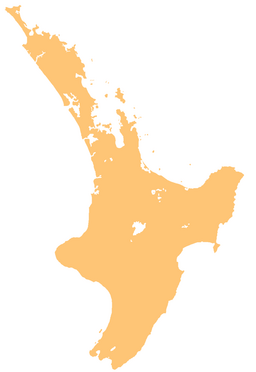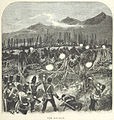Earth:Tauranga Volcanic Centre
| Tauranga Volcanic Centre | |
|---|---|
| <mapframe text="Map of selected surface volcanic features of the Tauranga Volcanic Centre alone (see other map on this page for volcanic relationships). Much of the centre to the south is buried under the Mamaku ignimbrite from the Rotorua Caldera which may extend even to Matakana Island in Tauranga Harbour. There is one basaltic centre (gray) on the island. The buried approximate outline of the postulated Omanawa Caldera which likely contributed to Centre ignimbrites is in pale white towards present Lake Rotorua. Brown shows the Waiteariki Ignimbrite. If you click on the map you will enable mouseover of volcano feature/wikilink. Characterised vents are black rectangles. Rhyolite fields from known vents is in red (geologically typed as Minden rhyolite) and andesite from the Otawa Formation is pink. Purple is Papamoa Ignimbrites.'"`UNIQ--ref-00000000-QINU`"''"`UNIQ--ref-00000001-QINU`"''"`UNIQ--ref-00000002-QINU`"''"`UNIQ--ref-00000003-QINU`"'" zoom="9" align="right" longitude="176.05" height="250" class="no-icon" latitude="-37.8" width="270">{{Wikipedia:Map data/Tauranga Volcanic Centre}}</mapframe> | |
| Highest point | |
| Coordinates | [ ⚑ ] : 37°42′47″S 176°02′38″E / 37.713°S 176.0438°E |
| Geography | |
| Geology | |
| Age of rock | 2.4–1.9 Ma[1] |
| Mountain type | Multiple |
| Volcanic arc/belt | Taupō Volcanic Zone |
| Last eruption | 1.9 Ma[1] |
The Tauranga Volcanic Centre is a geologic region in New Zealand's Bay of Plenty. It extends from the southern end of Waihi Beach and from the old volcanoes of the Coromandel Peninsula that make up the northern part of the Kaimai Range, towards the Taupō Volcanic Zone.
It was the site, about 2.1 million years ago, of the large single eruption event of Waiteariki ignimbrite with DRE of 870 ± 87 km3 (209 ± 21 cu mi).[5]:{{{1}}}
Geology
<mapframe text="Map of selected volcanic features of the Tauranga Volcanic Centre, allowing wider volcanic context but therefore with different shading to the other map on this page. {{Wikipedia:Map data/Northern North Island Volcanics/key}}" zoom="9" align="right" longitude="176.05" height="300" class="no-icon" latitude="-37.8" width="300">{{Wikipedia:Map data/Northern North Island Volcanics}}</mapframe> The Tauranga Volcanic Centre is at the intersection of the Hauraki and Taupō Rifts and was active during a period of tectonic transition from 2.95 to 1.9 million years ago when major volcanism moved south in Zealandia from the Coromandel Volcanic Zone. It thus has importance geologically as a region of transition, previously classified as part of the Central Volcanic Region,[6] which appears to have commenced as early as 4.5 million years ago from compositional analysis of sea floor eruptives.[7]
Part of it to the north west is sometimes defined separately in the literature as the Kaimai Volcanic Centre. However this now seems an artificial distinction as the activity and volcanic rock types over lap in time and type. For example the Waiteariki Formation is ignimbrite whose associated tephra must almost certainly have come from a now buried super volcano event at the north eastern margins of the old Taupō Rift, and it makes up much of the southern Kaimai Range where not covered by younger rhyolite.[2] The Omanawa Caldera is inferred by an area of gravity and magnetic anomaly that exists to the north-west of the Rotorua Caldera,[3] and this postulated feature buried perhaps under over a hundred meters of Mamaku ignimbrite from the Rotorua Caldera defines the southern portion of the Centre[1]
The Waiteariki ignimbrite erupted 2.1 million years ago.[4] but there are at least eight other large eruptions that occurred in the Tauranga Volcanic Centre in its period of activity.[2] Along with the eroded andesitic stratovolcano that resulted in the Otawa Formation at least 17 rhyolite-rhyodacite lava dome complexes contribute to what has been called the Minden rhyolite subgroup. To add complexity, like presently found in currently active caldera complexes in the Taupō Volcanic Zone, are the distinct Papamoa ignimbrite formations (dated to 2.21 ± 0.1 million years ago)[1] and a small basalt lava flow on Matakana Island (dated to 2.7 ± 0.1 million years ago). Mount Maunganui that forms one of the heads of the main entrance to Tauranga Harbour erupted 2.35 ± 0.06 million years ago and is the most recognised volcano of the Centre but other volcanoes nearby have been used as Pās by the Māori.
Compositional analysis has linked the Maungatūtū/Mount Misery dome that is dated to 2.69 ± 0.03 Ma to the younger nearby undated Greenpark and Pukunui rhyolite domes.[8]:i
The Otawa stratovolcano erupted first as long ago as 2.95 million years ago south of Tauranga. It has hornblende and pyroxene basaltic andesite to dacite lavas and breccias with a present area of 35 km2 (14 sq mi).[1] The most northern Bowentown dome is assigned to the Centre tentatively which has the advantage of a possible separation of about 2 million years in known activity of the Coromandel Volcanic Zone to its north from that of the Tauranga Volcanic Centre.[1] Minden Peak may have erupted most recently of all the volcanoes in the Centre.[1]
Relations to other volcanic activity
At the same approximate time the Centre was active to its west in Zealandia the Alexandra Volcanic Group was active.[1]
| Formations | Deposit/Volcano names | Age range estimate by various methods/samples (if only one method ± error) |
Notes (including location[9]) |
|---|---|---|---|
| Minden Rhyolite Subgroup | Minden Peak | 1.53 to 2.16 Ma | [ ⚑ ] 37°42′47″S 176°02′41″E / 37.7130976°S 176.0447332°E |
| Papamoa Formation | Papamoa ignimbrites: Welcome Bay, Wharo, Arateka, Otawera | 1.9 to 2.40 Ma | [ ⚑ ] 37°43′S 176°17′E / 37.72°S 176.29°E[8]:21 Ignimbrite classification,[10]:{{{1}}} Ongatiti ignibrite in the formation is from the Mangakino Caldera[8]:22 |
| Minden Rhyolite Subgroup | Otanewainuku | 1.95 ± 0.02 Ma | [ ⚑ ] 37°52′S 176°14′E / 37.87°S 176.24°E |
| Waiteariki Formation | Waiteariki ignimbrite | 2.09 to 2.25 Ma | DRE = 870 ± 87 km3 (209 ± 21 cu mi) from postulated Omanawa Caldera.[5] |
| Minden Rhyolite Subgroup | Puwhenua | 2.14 ± 0.05 Ma | [ ⚑ ] 37°55′36″S 176°07′04″E / 37.9266082°S 176.1178912°E |
| Minden Rhyolite Subgroup | Kaimai | 2.20 to 2.86 Ma | [ ⚑ ] 37°51′37″S 175°55′31″E / 37.8603531°S 175.9252746°E |
| Minden Rhyolite Subgroup | Waikite | 2.25 to 2.37 Ma | [ ⚑ ] 37°45′16″S 176°12′38″E / 37.7543176°S 176.2105643°E |
| Minden Rhyolite Subgroup | Papamoa | 2.25 to 2.88 Ma | [ ⚑ ] 37°44′S 176°17′E / 37.73°S 176.28°E |
| Minden Rhyolite Subgroup | Mangatawa | 2.28 to 2.45 Ma | [ ⚑ ] 37°42′11″S 176°14′34″E / 37.7029741°S 176.2427757°E |
| Minden Rhyolite Subgroup | Maunganui | 2.35 ± 0.06 Ma | [ ⚑ ] 37°37′49″S 176°10′19″E / 37.6302726°S 176.1719492°E |
| Minden Rhyolite Subgroup | Kaikaikaroro | 2.39 ± 0.06 Ma | [ ⚑ ] 37°47′17″S 176°00′07″E / 37.7880849°S 176.0018525°E |
| Minden Rhyolite Subgroup | Bowentown | 2.51 to 2.83 Ma | [ ⚑ ] 37°27′54″S 175°59′20″E / 37.4648934°S 175.9887865°E |
| Minden Rhyolite Subgroup | Kopukairua | 2.53 to 2.69 Ma | [ ⚑ ] 37°44′S 176°14′E / 37.73°S 176.23°E Has one earlier but inconsistent age |
| Minden Rhyolite Subgroup | Upuhue | 2.53 to 2.84 Ma | [ ⚑ ] 37°42′44″S 176°15′35″E / 37.7122321°S 176.2596982°E |
| Otawa Andesite Formation | Otawa stratovolcano | 2.54 to 2.95 Ma | [ ⚑ ] 37°47′S 176°16′E / 37.78°S 176.26°E |
| Minden Rhyolite Subgroup | Pukunui | 2.21 - 2.54 Ma | [ ⚑ ] 37°46′42″S 176°12′16″E / 37.77845°S 176.20432°E Age constrained to this range but undated[8]:93 |
| Minden Rhyolite Subgroup | Waitao | 2.64 to 2.71 Ma | [ ⚑ ] 37°44′32″S 176°13′21″E / 37.7421075°S 176.2224000°E |
| Minden Rhyolite Subgroup | Greenpark | 2.21 - 2.69 Ma | [ ⚑ ] 37°49′22″S 176°12′05″E / 37.822711°S 176.201388°E Age constrained to this range but undated[8]:i |
| Minden Rhyolite Subgroup | Maungatūtū/Mount Misery | 2.69 ± 0.03 Ma | [ ⚑ ] 37°48′24″S 176°11′20″E / 37.806692°S 176.189007°E[8]:5 |
| Matakana Formation | Matakana Island Basalt | 2.7 ± 0.1 Ma | [ ⚑ ] 37°36′07″S 176°02′35″E / 37.602°S 176.043°E |
| Minden Rhyolite Subgroup | Kakahu | 2.87 ± 0.02 Ma | [ ⚑ ] 37°57′47″S 175°56′15″E / 37.962993°S 175.937512°E Technically the vent is in the Waikato region |
Mount Maunganui from Moturiki Island
The view from the Papamoa Hills towards Mount Maunganui taking in the Papamoa ignimbrite formations and that includes the Upuhue and Mangatawa vents.
References
- ↑ 1.0 1.1 1.2 1.3 1.4 1.5 1.6 1.7 1.8 1.9 Pittari, Adrian; Prentice, Marlena L.; McLeod, Oliver E.; Zadeh, Elham Yousef; Kamp, Peter J. J.; Danišík, Martin; Vincent, Kirsty A. (2021). "Inception of the modern North Island (New Zealand) volcanic setting: spatio-temporal patterns of volcanism between 3.0 and 0.9 Ma". New Zealand Journal of Geology and Geophysics 64 (2–3): 250–272. doi:10.1080/00288306.2021.1915343. https://fl-nzgs-media.s3.amazonaws.com/uploads/2021/08/Ref.6C-c_North-Island-NZ-VolcanicSettingBetween3.00.9MaPittari-et-al.-2021_.pdf.
- ↑ 2.0 2.1 2.2 Prentice, Marlena; Pittari, Adrian; Lowe, David J.; Kilgour, Geoff; Kamp, Peter J.J.; Namaliu, Miriam (2022). "Linking proximal ignimbrites and coeval distal tephra deposits to establish a record of voluminous Early Quaternary (2.4–1.9 Ma) volcanism of the Tauranga Volcanic Centre, New Zealand". Journal of Volcanology and Geothermal Research 429 (107595): 107595. doi:10.1016/j.jvolgeores.2022.107595. ISSN 0377-0273. https://www.sciencedirect.com/science/article/pii/S0377027322001263.
- ↑ 3.0 3.1 Stagpoole, V; Miller, C; Caratori, Tontini F; Brakenrig, T; Macdonald, N (2021). "A two million-year history of rifting and caldera volcanism imprinted in new gravity anomaly compilation of the Taupō Volcanic Zone, New Zealand". New Zealand Journal of Geology and Geophysics 64 (2–3): 358–371. doi:10.1080/00288306.2020.1848882. https://www.tandfonline.com/doi/full/10.1080/00288306.2020.1848882.
- ↑ 4.0 4.1 Prentice, Marlena; Pittari, A.; Kamp, P; Lowe, David J. (2020). "The 2.1 Ma Waiteariki Ignimbrite: Defining a new super-eruption at the onset of TVZ volcanism". Geoscience NZ 2020. https://www.researchgate.net/publication/346368760.
- ↑ 5.0 5.1 Prentice, Marlena Lee (2023). Silicic volcanism of the Tauranga Volcanic Centre and the climactic Waiteariki supereruption at the dawn of the Taupō Volcanic Zone; PhD dissertation (PDF) (Thesis). The University of Waikato. Retrieved 10 September 2023.
- ↑ Cole, J.W.; Darby, D.J.; Stern, T.A. (1995). "Taupo Volcanic Zone and Central Volcanic Region: Backarc Structures of North Island, New Zealand". in Taylor, Brian. Backarc Basins: Tectonics and Magmatism. New York: Plenum. p. 3. ISBN 978-1-4615-1843-3.
- ↑ Pank, K; Kutterolf, S; Hopkins, JL; Wang, KL; Lee, HY; Schmitt, AK (2023). "Advances in New Zealand's tephrochronostratigraphy using marine drill sites: The Neogene". Geochemistry, Geophysics, Geosystems 24 (8): e2023GC010866. doi:10.1029/2023GC010866.
- ↑ 8.0 8.1 8.2 8.3 8.4 8.5 Kinley, Taya (2022). Volcanic history of the Mount Misery rhyolite domes, Tauranga Volcanic Centre; MSc dissertation (PDF) (Thesis). The University of Waikato. Retrieved 10 September 2023.
- ↑ https://www.topomap.co.nz
- ↑ Namaliu, Miriam Darusila Mangon (2021). Volcanic geology of the early Pleistocene ignimbrite succession in the western Papamoa Region, Bay of Plenty. MSc Dissertation (Thesis). The University of Waikato. Retrieved 15 September 2023.
 |








